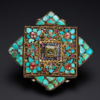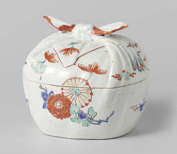JAMES C.S. LIN
Senior Curator of Chinese Art, Fitzwilliam Museum, University of Cambridge

IN MY RESEARCH on Chinese reverse-painted glass mirrors, I came across an export painting that was described as Chinese Reverse Glass Painter. Versions can be found in several museum and private collections. One example, measuring 36.2 × 27.9 cm, used to be in the collection of the Martyn Gregory Gallery, but is now in the A.J. Hardy Collection (1). Three other paintings with variations in detail are in the respective collections of the British Library (2) (36.8 × 27 cm) and the Victoria and Albert Museum (V&A) (3) (42 × 35 cm) in London and the Peabody Essex Museum (PEM) (4) (38.1 × 29.9 cm) in Salem, Massachusetts.
The figures are depicted transposing a drawing onto a glass panel on the table. Each is holding a Chinese brush in the right hand with arms resting on a wooden board across the framed glass panel. Armrests are commonly used when Chinese painters or calligraphers execute works to prevent the ink or pigments transferring to their arms, thus ruining the paper. In this case, the armrest across the frame also prevents the weight of the arm from breaking the glass. Close observation shows that these gouaches are all slightly different although the figural gestures are similar, and the chair and table appear identical.
The gouache from the collections of the British Library and the PEM is one of the 100 leaves that depicts Street and Marketplace Occupations in Canton (Guangzhou) during the late Qing dynasty (1644–1911) (晚清廣東百行人物畫, Wan Qing Guangdong bai hang ren wu hua). Each painting from the PEM album was painted within a printed double square frame with a printed red number at the centre bottom, indicating its series number in the album, which is different from other paintings I have seen. This painting is numbered twenty-one, with two Chinese characters, 寫畫 (xie hua), written at the bottom right. In the case of the British Library, twenty-four portraits of Chinese emperors, officers and their consorts from prehistory to the Qing dynasty were combined with seventy-six street workers to make up 100 leaves. This seems to suggest painting studios in Canton produced luxury bindings for loose paintings for customers. Apart from the 100 Street and Marketplace Occupations, sets of twelve, twenty-four or even forty-eight paintings in various subjects, such as tea planting and ceramic making, were also popular at that time.

The version from the British Library depicts the artist copying a Western landscape, showing a shepherd herding two cows with a dog running ahead and a blurry ox cart in the background. A palette of colours, a two-component brush washer and some paper to dry the brush are at the right-hand side of the artist. Judging from the colours on the palette he might be at the stage of applying colour onto the glass. At the bottom right corner, two Chinese characters, 寫畫 (xie hua), appear next to a red crown image with “B.M.” underneath.
The painting from the A.J. Hardy Collection depicts an artist copying a young woman with naked breasts onto the glass panel. The angle the artist holds the brush is different from the previous painting from the British Library. The colour palette, different sized brushes and possible inkstone are displayed at the right of the artist, and the little pieces of paper to dry the brush are on the left. A small rectangular wood panel is placed on top of the inkstone, making it difficult to tell if it might be a brush washer like the one in the British Library. However, judging from the monochrome on the palette, it appears that the artist is at the earlier stage of outlining the image he is transposing rather than applying colours onto the glass, as Audric has suggested.

The artist in the V&A’s picture is depicting a seated European girl with a simple background. The sketch is framed and hung in front of the artist. The way the artist holds the brush between the third and fourth fingers indicates that he was a trained Chinese brush painter. Four more brushes are scattered between the inkstone and the colour palette on the right and more tissues for drying the brush are on the left, some of them used and rubbed. We can clearly see the artist is at the last stage of completing the glass with various colours. However, the image he is transposing onto the glass looks like a landscape instead of the sketch hung in front of him. “No.55” is marked at the bottom of this gouache suggesting it is the fifty-fifth painting in this album. “D 107-98” is written on the bottom right. The painting at the British Library is executed in a portrait format, whilst the example from the V&A is in a horizonal format on rice paper, but the size of the images in both paintings is similar.

The painting from the PEM is executed in opaque watercolour on paper, dated to circa 1792 or later, by the studio of Pu Qua (active 1780–1800s). The artist in the painting is depicting a European lady running in the woods with her right foot raised. Under this sketch there is some illegible writing with “1792” at the end, which could be the reason the painting was given this date. A two-component blue and white brush washer, a colour palette and four more brushes are neatly arranged at the right-hand side of the artist. The way the artist holds the brush is very close to the figure in the V&A’s version, but with the thumb placed vertically to support the brush and the middle finger gently touching the brush, which is a more accurate position while executing a Chinese painting. Some long lengths of tissue for drying the brush are at the left-hand side of the artist, who is cleaning his left hand with tissue.
Compared to other paintings, the dress of the artist in the PEM example is paler and less wrinkled, but his queue is different from the others. The artist’s shoes in the four paintings are all of different colours and the facial details of each artist are also all different. The artist in the V&A picture has rolled up his sleeves and reveals a white garment underneath. This suggests it could be an autumn dress, as Canton is humid and two layers of clothing are usually worn in the cooler season. In addition, the style of table and chair in all the paintings is identical, but the tones of colour are all different, particularly the chair from the V&A example, which is painted a greyish green. Above all, the PEM’s painting does not depict shadows cast by the furniture.

The similar composition of these paintings, but differences in detail and size of paper, indicate they were likely produced in different workshops by freehand copying while sharing a common blueprint. A template shared by different artists in the same studio is also possible, but the variations in size of paper and detail of the objects on the artist’s table reduces this possibility. The printed number on the paper from the PEM version seems to suggest that this painting was executed in a more organised workshop. This painting was attributed to the studio of Pu Qua, which is one of the few Canton workshops that has been recorded. So far, we do not have enough records to identify the workshops in Canton but, judging from the large demand for export paintings for the European market, there are likely to have been many workshops of different scale, as painting quality varies.
The engravings being transposed are all European subjects and thus very likely for the European market, particularly the ones portraying nudity, such as the example from the collection of A.J. Hardy. As Maggie Cao suggests, the process of making reverse-painted glass mirrors involved the artist tracing the original image onto the sheet of glass placed directly over it. Then he turned over the transparent sheet to fill in a now-reversed composition. If the artist placed a new glass sheet on top of this completed reversed-glass and repeated the same process, he would have an identical and symmetrical image, like the pair of glass mirrors displayed by the London dealer, Marchant, during Asian Art in London in November 2024 (5).

The drawings discussed above depict the stage that the artist is painting freehand on a horizontal glass surface with the original print hanging in front of him. However, these drawings only depict artists working on a glass painting that fits onto the table, likely to be small glass panes or a small section of a bookcase, such as the example that was previously part of Ann and Gordon Getty’s collection (6) or even a side panel from the larger mirror at the Fitzwilliam Museum (7). This type of small-scale workshop would have seemingly been unable to produce a large glass painting, such as The Emperor’s Audience in the collection of the V&A (115.6 × 190.5 cm), not to mention the even more complicated reverse-painted glass mirrors in various European collections, which are mostly more than 1 m long and at least 50 cm in width. These mirrors simply could not be executed using the small tables depicted in the images illustrated in this article.


Judging from the complicated procedure of making reverse-painted glass mirrors, larger examples must have been produced in a bigger studio with job division along a production line. Pierre-Martial Cibot (1727–1780), the French Jesuit missionary, recorded in his Memoires concernant that the imperial atelier was divided into three large rooms, not including the one reserved for European artists. Canton painters worked in one of these rooms exclusively on reverse-glass paintings. They first painted their designs in oils on paper which they then moistened with l’esprit-de-vin chaud. While other artisans were preparing the colours for application, one of the painters carefully cut the design out of paper (découpe le papier) and transferred it to the glass. After it had dried out, the subject matter was coloured in, with only the smallest quantity of paper allowed to remain on the glass. The production centre of reverse-painted glass mirrors in Canton must have used a similar process flow to produce these mirrors in time for the market demand.

In terms of European subjects on reverse-painted glass mirrors, engravings and watercolour paintings were sent to Canton to be copied. William Hogarth’s (1697–1764) print, A Chinese Tavern Scene, was adopted and reimagined onto a punch bowl and a reverse-painted glass mirror. For the Chinese subject genre on reverse-painted glass mirrors, it is very likely that these workshops may have had…
Please click here to view the contents of this issue.

 Subscribe
Subscribe Calendar
Calendar Links
Links Gift
Gift


